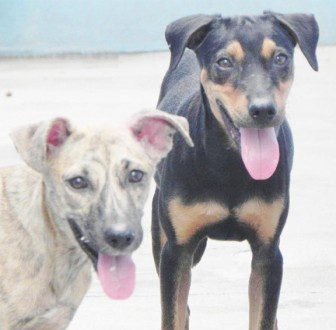Let us today begin with a new chapter – a discourse on wounds.
Dealing with fresh wounds
There are all sorts of reasons that cause lesions in the skin and underlying tissue. We will today be dealing with those that are associated with some mechanical trauma (a willful chop, a gunshot wound, an accidental cut from a sharp object, etc).
In the case of wounds, the two most important objectives are first to stop the bleeding and then to prevent infection. Since wounds are painful to the dog, be prepared to restrain or muzzle it, before you treat the wound.
Control of bleeding
 Bleeding may be arterial (the spurting of bright red blood) or venous (oozing of dark red blood), or sometimes both. Do not wipe a wound which has stopped bleeding. This will dislodge the clot. Don’t pour peroxide on a fresh wound. Bleeding then will be difficult to control.
Bleeding may be arterial (the spurting of bright red blood) or venous (oozing of dark red blood), or sometimes both. Do not wipe a wound which has stopped bleeding. This will dislodge the clot. Don’t pour peroxide on a fresh wound. Bleeding then will be difficult to control.
The two methods used to control bleeding are the pressure dressing and the tourniquet.
The pressure dressing
Take several pieces of clean sterile gauze, place them over the wound, and bandage snugly. Watch for swelling of the limb below the pressure pack. This indicates impaired circulation. The bandage must be loosened or removed.

An alternative method to control bleeding in the extremities is to apply pressure over the artery in the area of the groin or armpit. Often, this will control bleeding enough to permit an assistant to apply a pressure dressing.
If material is not available for bandaging, place a dish-washing sponge-like material or a wad of cloth on the wound and press it firmly. Hold in place until help arrives.
The tourniquet
A tourniquet may be needed to control a spurting artery. It can be applied to the leg or placed above the wound (between the wound and the heart). Take a piece of cloth or gauze roll and loop it around the limb. Then tighten it by hand, or with a stick inserted beneath the loop and twisted around until bleeding is controlled. If you see the end of the artery, you might attempt to pick it up with tweezers and tie it off with a piece of cotton thread. When possible, this should be left to a trained practitioner.
A tourniquet should be loosened every 30 minutes for two or three minutes to let blood flow into the limb.
After the bleeding is controlled/contained, the next step is to manage the wound so as to ensure healing as quickly as possible. The first step in wound management is to stabilize the animal’s condition; after all, there might have been great blood loss.
A glucose-saline drip can be introduced; metabolic stimulants may be administered following your vet’s advice.
Later, the wound must be protected from further contamination, after washing out (not with hydrogen peroxide) the existing dirt and debris with clean water or commercially available antiseptic solutions. Cover the wound with a sterile dressing material (preferably boiled gauze) and carry the animal to your vet. He/she can show you how to place and secure the dressing. Your vet will also advise you on the antibiotic usage, if needed, and decide whether to stitch the wound closed or not.
Please implement disease preventative measures (vaccinations, routine dewormings, monthly anti-heartworm medication, etc) and adopt-a-pet from the GSPCA’s Animal Clinic and Shelter at Robb Street and Orange Walk, if you have the wherewithal to care well for the animals. Do not stray your unwanted pets, take them to the GSPCA’s Clinic and Shelter instead. If you do not wish your pet to have puppies or kittens, you may exploit the GSPCA’s free spay and neutering programme. If you see anyone being cruel to an animal, or if you need any technical information, please get in touch with the Clinic and Shelter by calling 226-4237.









